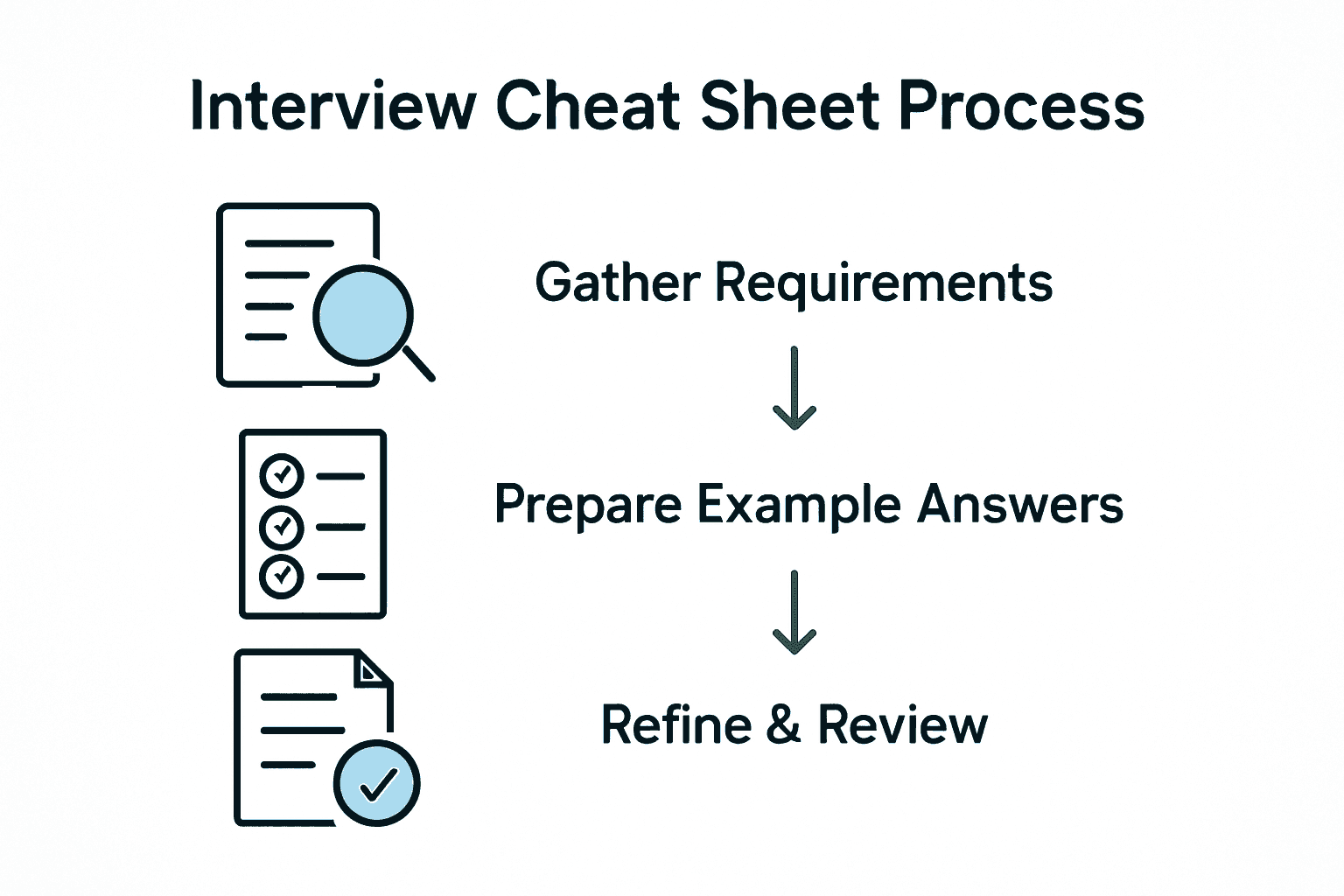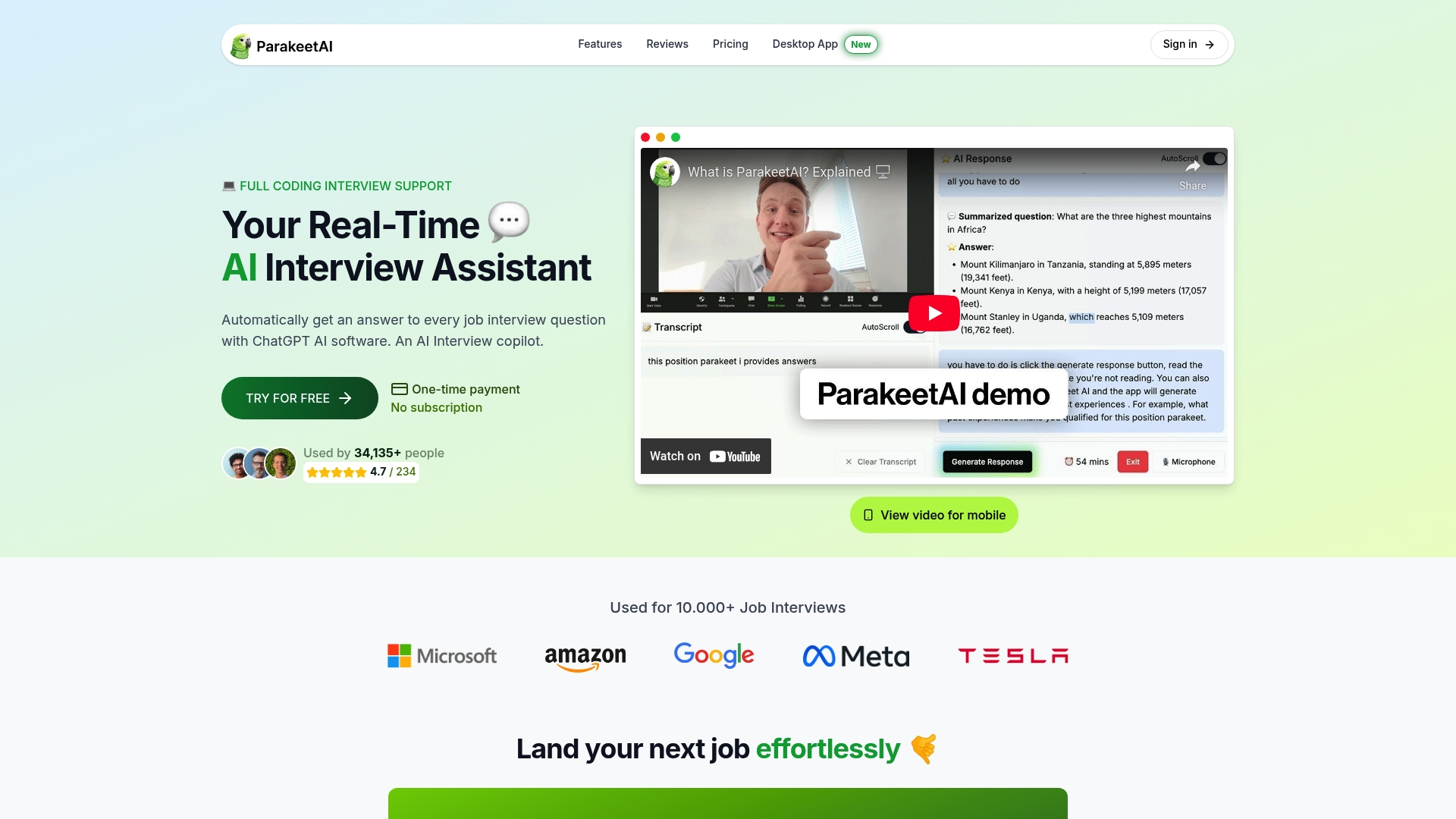How to Create Interview Cheat Sheets for Success

Did you know that job seekers who prepare tailored interview responses are up to 50 percent more likely to receive an offer? Interview preparation goes far beyond glancing at a job description. Understanding exactly what an employer wants and showcasing achievements that match those needs can make all the difference. This step-by-step approach helps you organize information, anticipate interview questions, and turn your experiences into stories that stand out to hiring managers.
Quick Summary
| Key Point | Explanation |
|---|---|
| 1. Analyze the job description thoroughly | Dissect job requirements to identify necessary skills and experiences, creating a roadmap for interview success. |
| 2. Prepare for common interview questions | Compile a categorized list of potential questions to build confidence and prepare strategic responses. |
| 3. Use structured response frameworks | Implement frameworks like STAR for clarity, allowing you to present answers in a compelling manner. |
| 4. Incorporate measurable examples | Transform generic responses into stories showcasing achievements with quantifiable outcomes to stand out. |
| 5. Refine cheat sheets for clarity | Review notes to ensure they are concise and impactful, making them effective tools in your preparation. |
Table of Contents
- Step 1: Gather Essential Job Information And Requirements
- Step 2: Research Common Interview Questions
- Step 3: Organize Answers Using Structured Templates
- Step 4: Incorporate Personalized Examples And Achievements
- Step 5: Review And Refine Your Cheat Sheets For Clarity
Step 1: Gather essential job information and requirements
Successfully preparing for a job interview begins with understanding the job description inside and out. In this step, you will learn how to dissect the job requirements and create a strategic roadmap for interview success.
Start by carefully analyzing the job description. According to research from interview experts, using a three-column analysis approach allows you to map out exactly what employers are seeking. Create a table or worksheet with three key columns: job requirements, matching personal experiences, and skill gaps.
Read the job description multiple times and highlight critical elements:
- Required skills
- Specific experiences
- Technical competencies
- Preferred qualifications
For each requirement, find concrete examples from your professional history that demonstrate your capabilities. If a job asks for “5 years of digital marketing experience managing social media campaigns,” you would note a specific campaign you led, its reach, and measurable outcomes.
Pro Tip: Quantify everything. Numbers speak louder than generic statements.
If you identify skill gaps during your analysis, do not panic. Instead, prepare to discuss how you are actively working to develop those skills or highlight transferable experiences that showcase your learning potential.
With your job requirements mapped out, you are now ready to move on to crafting personalized interview responses that precisely match what employers are seeking.

Step 2: Research common interview questions
Now that you have mapped out job requirements, the next crucial step is preparing for potential interview questions. Your goal is to build a comprehensive understanding of the types of questions you might encounter and develop confident, strategic responses.
Research shows that compiling a categorized list of common interview questions provides an excellent foundation for interview preparation. According to industry research from the Work in Sports resource center, creating a broad base of potential questions helps candidates feel more prepared and confident.
Focus on several key question categories:
- Behavioral questions
- Technical skill assessments
- Personal background inquiries
- Career aspiration questions
- Situational problem solving scenarios
Pay special attention to behavioral questions. According to research from the March Ang Group, these questions remain central to modern interviewing techniques. Prepare using the STAR framework Situation, Task, Action, Result to structure your responses effectively.
Pro Tip: Practice answering questions out loud to build genuine confidence and smooth delivery.
Beyond standard questions, anticipate queries about industry trends, work preferences, and emerging technologies relevant to your field. Modern interviews often explore not just your current skills but your potential for future growth and adaptability.
With a comprehensive question list prepared, you are now ready to develop specific response strategies that highlight your unique professional strengths.
Step 3: Organize answers using structured templates
With your list of potential interview questions prepared, the next critical step is developing clear, concise, and compelling response templates. Structured frameworks will transform your interview preparation from reactive to proactively strategic.
According to research from interview experts, several powerful frameworks can help you craft memorable answers. When preparing your best interview answers, focus on proven storytelling structures that demonstrate your skills effectively.
Key structured templates include:
- STAR Method (Situation, Task, Action, Result)
- Problem Solution Benefit framework
- Challenge Approach Outcome narrative
- Reverse Chronological storytelling
The STAR method works particularly well for behavioral questions. Start by describing a specific situation, outline the task you needed to complete, detail the actions you took, and conclude with the concrete results of your efforts. This approach allows you to showcase your problem solving skills while providing clear evidence of your capabilities.
Pro Tip: Practice each template with your actual professional experiences to make them sound natural and authentic.
Choose the template that best matches the type of question you are answering. Technical questions might require a Problem Solution Benefit approach, while leadership queries work well with Challenge Approach Outcome narratives.
Here’s a structured overview of popular response frameworks:
| Framework | Best For | Structure |
|---|---|---|
| STAR Method | Behavioral questions | Situation Task Action Result |
| Problem Solution Benefit | Technical/problem-solving | Problem Solution Benefit |
| Challenge Approach Outcome | Leadership/strategy | Challenge Approach Outcome |
| Reverse Chronological | Career progress | Most recent Previous roles Key growth |
By systematically organizing your answers using these structured templates, you transform potentially meandering responses into sharp, impactful statements that capture an interviewer’s attention.
Step 4: Incorporate personalized examples and achievements
Transforming generic interview responses into compelling narratives requires strategic storytelling that showcases your unique professional journey. This step focuses on turning your background into a powerful demonstration of your capabilities.
According to research from interview experts, matching each job requirement with specific quantifiable examples anchors your claims in real achievements and directly underscores your alignment with employer priorities.
Start by revisiting the job description and identifying key skills and requirements. For each critical requirement, develop a corresponding personal story that illustrates:
- Specific professional context
- Your direct role and contributions
- Measurable outcomes and impact
- Relevant technical or soft skills demonstrated
Quantification is crucial. Instead of saying “I improved team productivity,” specify “Implemented a project management system that increased team productivity by 42% and reduced project completion times by two weeks.”
Pro Tip: Choose examples that not only prove your skills but also reveal your problem solving approach and professional values.
Focus on diverse achievements that reveal different dimensions of your professional capabilities. Select stories that highlight adaptability, leadership, technical expertise, and collaborative skills.
By crafting personalized, data driven narratives, you transform a standard interview into a compelling presentation of your professional potential.
Step 5: Review and refine your cheat sheets for clarity
With your interview preparation materials assembled, the final crucial step is transforming your raw notes into a polished strategic resource. This refinement process ensures your cheat sheets are crisp, clear, and genuinely useful during interview preparation.
Begin by conducting a comprehensive review of your materials. Read through each section critically, asking yourself if an outside observer could quickly understand the key points. Your goal is creating a document that communicates your professional strengths concisely and powerfully.
Key refinement strategies include:
- Eliminating redundant information
- Simplifying complex explanations
- Highlighting most impactful achievements
- Ensuring logical flow between sections
- Using clear concise language
Read your cheat sheets out loud to test their natural rhythm and comprehension. If you stumble while speaking or find sections confusing, that signals an area needing simplification.
Pro Tip: Have a trusted friend or mentor review your cheat sheets for an objective perspective.
Organize your content strategically. Group related experiences and skills together. Use bullet points for quick readability but balance them with brief explanatory paragraphs that provide context and depth.
Remember that your cheat sheets are a dynamic tool. Be prepared to update them as you gain new experiences or receive feedback from practice interviews. Continuous refinement transforms these documents from static notes to powerful interview preparation resources.

Struggling to Remember Your Cheat Sheet Answers in Real Interviews?
You have just spent hours preparing job-specific examples and structured responses for your next interview. Yet when nerves hit and questions come fast, it is easy to forget all your hard work. Many candidates know the pressure of having to recall the right achievement or the perfect STAR response on the spot. Even with polished cheat sheets, it is normal to feel anxious about missing key points or stumbling over your words.

Take control with Parakeet AI, your real-time interview assistant. Parakeet listens alongside you and delivers AI-powered answers and reminders for every question. Merge your personalized interview cheat sheets with advanced technology that keeps you prepared, sharp, and confident. Do not let another opportunity slip by due to nerves or memory lapses. Discover how Parakeet AI can elevate your interview performance right now. Your preparation deserves a platform that delivers real results. Visit Parakeet AI to try it for your upcoming interview.
Frequently Asked Questions
How can I effectively gather job information for my interview cheat sheet?
To effectively gather job information, analyze the job description closely and identify key requirements. Create a three-column worksheet that includes job requirements, your matching experiences, and any skill gaps.
What common interview questions should I include in my cheat sheet?
Your cheat sheet should include common interview questions categorized by types, such as behavioral, technical, and situational questions. Research these question categories to compile a comprehensive list that covers various aspects of the job you’re applying for.
How do I structure my answers in my interview cheat sheet?
You can structure your answers using frameworks like STAR (Situation, Task, Action, Result) or Problem Solution Benefit. Choose a framework that fits the question type to ensure your responses are clear and impactful.
What types of examples should I include in my interview cheat sheet?
Include specific examples of your achievements that highlight your skills relevant to the job requirements. For instance, mention a project where you increased team productivity by a measurable percentage.
How should I refine my interview cheat sheet for clarity?
To refine your cheat sheet, eliminate redundant information and simplify complex explanations. Ensure that it flows logically and communicates your strengths clearly, making it easy to review a few days before the interview.
How often should I update my interview cheat sheet?
Update your interview cheat sheet regularly, especially after gaining new experiences or receiving feedback during practice interviews. Aim to review and refresh your materials at least once a month to keep them relevant and useful.




